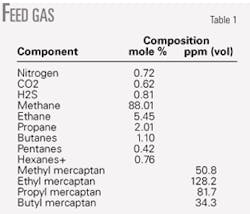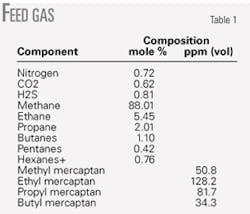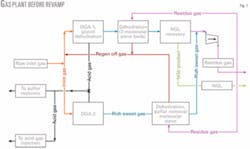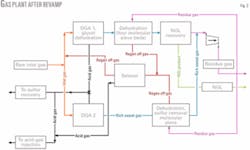Mark E. Treesh
Richard J. Aves
Marathon Oil Co.
Houston
At its Indian Basin gas plant, Marathon Oil Co. is using molecular sieve for primary mercaptan removal and Selexol for treating the regeneration gas to meet pipeline specifications. The gas streams meet pipeline specifications and the NGL stream recovered downstream from mercaptan removal also complies with pipeline sulfur specifications without further treating.
Molecular sieves are commonly used to remove water from high-pressure gas streams and mercaptans and other contaminants from liquid product streams. Only a few plants worldwide, however, use molecular sieves to remove mercaptan compounds from process gas streams. Most of those plants use the sulfur-containing regeneration gas stream for fuel, which commonly has lower quality standards than pipeline-quality gas.
This article describes details of the configuration that Marathon chose at its Indian Basin gas plant for mercaptan removal from the process gas stream prior to cryogenic NGL recovery. The configuration uses unique process steps to minimize the project’s capital costs and operating costs while maintaining reliable operability of the overall system.
This article also addresses some of the problems that were encountered during implementation of this process and offers suggestions for future projects of a similar nature.
Indian Basin plant
Marathon’s Indian Basin gas plant in Southeastern New Mexico was originally designed and built as a lean-oil absorption plant. In the early 1980s, the process configuration was upgraded to a cryogenic NGL recovery plant. In 1999 and 2000 the plant capacity was expanded to process up to 300 MMscfd.
In 2001, Marathon addressed the issue of total sulfur in the NGL product. It was not a concern before 2001 because the liquid product pipeline company had not strictly enforced the specification.
Table 1 shows the plant’s typical inlet-gas composition. The plant produces as much NGL from the inlet gas as possible while maintaining the methane-to-ethane ratio specification.
Process configuration
Before the mercaptan-removal project was implemented, the plant was made up of two distinct processing schemes. The main flow, approximately 240 MMscfd, is routed through an amine system (DGA 1) after inlet hydrocarbon-condensate separation. This amine system is designed to remove H2S and CO2 down to 4 ppm (vol) and 50 ppm (vol), respectively.
After the amine system, a glycol dehydration system reduces the water content of the gas to 7 lb/MMscf or less. A molecular-sieve dehydration system after the glycol system further dehydrates the gas before it enters cryogenic NGL recovery.
The NGL-recovery system consists of two turboexpander plants designed to recover as much of the NGL as possible while maintaining a methane-to-ethane molar ratio of 1.2 in the NGL.
About 60 MMscfd of the gas that is not processed in the main plant train flows through a separate amine system (DGA 2) also to remove H2S and CO2 down to 4 ppm (vol) and 50 ppm (vol), respectively. Gas from DGA 2 feeds a gas-water heat exchanger for cooling and then through separation.
Finally, the gas is polished with molecular sieve designed for dehydration and mercaptan sulfur removal. Regeneration gas from both molecular sieve beds was previously recycled to DGA 1 so that the cryogenic system would remove the mercaptans.
Fig. 1 shows a past configuration.
The Indian Basin gas plant has specifications for its residue-gas stream and the NGL product stream. The residue-gas pipeline specification only allows 0.5 grains of total sulfur in the gas stream.
The gas plant easily met this specification because the inlet mercaptan sulfur is condensed with the NGL during the cryogenic NGL recovery step. Before implementation of the mercaptan-removal project, however, condensation of these mercaptans caused the NGL sulfur content to be more than 1,500 ppm (wt).
In the past it was common practice to blend the natural gasoline product fractionated from the NGLs into the gasoline pool; therefore, the higher-sulfur NGLs containing the natural-gasoline blending product were not much of a concern.
After passage of the Clean Air Act, which called for refiners to produce lower-sulfur gasoline, the fractionators were unable to sell a natural-gasoline product with high sulfur levels to refiners as blendstock for the gasoline pool. This fact, along with greater volumes of NGLs produced from Indian Basin gas plant after two plant expansions, caused a more strict enforcement of the pipeline specifications.
These new issues prompted Marathon to evaluate mercaptan-sulfur removal technologies to treat the NGLs produced from the cryogenic plant. Marathon evaluated two different processes, NGL caustic treating and gas-phase mercaptan removal with molecular sieve.
The NGL caustic-treating system was a Merox-type regenerable system but could only reduce the total sulfur content of the NGL stream to 850-900 ppm. This was due to the presence of significant quantities of heavy mercaptans.
This process required a large capital investment for the major equipment including an extractor, knockout drum, NGL sand filter, caustic oxidizer, disulfide separator, and caustic circulation pumps. Disposal of the waste streams-disulfide oil and spent caustic-generated in this process was a concern identified during the evaluation. In addition to these concerns the estimated delivery of the equipment was also longer than the other option considered.
The gas-phase mercaptan-removal process included only one additional molecular-sieve bed and a Selexol system, which has a similar configuration to a typical amine system. The four beds, with new molecular sieve installed, were designed to remove mercaptans and water from the main process gas stream.
There was no place to dispose of the sour regeneration gas; therefore, this process required a new Selexol system, which was designed to remove most of the mercaptans from the sour regeneration gas from both molecular-sieve systems. After evaluating the two technologies, Marathon chose to install the gas-phase mercaptan-removal project due to lower capital and operating costs.
Fig. 2 shows the revised plant flow scheme.
After installation and start-up of the Selexol plant and the new molecular sieve beds, Marathon experienced an initial decrease in the total sulfur concentration in the NGL product stream to 500 ppm (wt). Unfortunately, this decrease was only temporary, and the total sulfur concentration rose 960 ppm (wt) during the first 2 weeks of operation.
Troubleshooting
Due to the poor initial molecular-sieve performance, Marathon initiated a thorough investigation to identify the causes. UOP LLC concluded that there were unforeseen issues with the gas-inlet temperature, the amount of water in the inlet gas, and the amount of aromatics and heavy hydrocarbons in the inlet gas.
According to UOP, the heavy hydrocarbons and aromatics were filling pore spaces and not allowing mercaptans to fill the spaces. Excess water is also a problem and must be kept out of the mercaptan-removal section of the bed because water will displace mercaptan compounds and has a higher equilibrium capacity on the sieve, which decreases mercaptan-removal capacity.
To solve the poor sieve performance, UOP recommended:
• Reducing the molecular-sieve inlet gas temperature. The high inlet temperature was probably the biggest contributor to poor sieve performance. UOP suggested an operating temperature of 90° F., 50° F. lower than the previous temperature of about 140° F.
• Eliminating the low heat step in the regeneration cycle to help remove excess water left on the bed during regeneration. This low heating step gradually desorbed the H2S-which is adsorbed in trace amounts during the process cycle-so the upstream amine treating systems would not be overwhelmed by a large H2S spike during regeneration. This step is unnecessary now due to the installation of the DGA-Selexol system to remove the mercaptans.
• Changing out the molecular sieve because the mercaptan-removal sieve had already been exposed to water and, as a result, had diminished capacity to remove mercaptans.
To achieve the temperature suggested in UOP’s first recommendation, Marathon relocated the existing DGA 1 plant inlet gas-water exchanger downstream from the amine contactor. Although relocating the gas-water exchanger lowered the molecular sieve inlet temperature, it also caused condensation of hydrocarbons upstream from the glycol dehydration unit.
The amine overhead coalescer could not remove condensed hydrocarbons to an acceptable level because the coalescer was only designed to remove entrained amine and water. Hydrocarbons passing into the glycol dehydration system were ending up in the glycol reboiler.
This additional hydrocarbon vaporization load was using reboiler duty and did not allow proper regeneration of the glycol. The poorly regenerated glycol then caused higher process-gas water loading in the gas entering the molecular sieve system.
Excessive water to the molecular-sieve beds results in lower mercaptan-removal capacity. The high inlet temperature was solved, but this solution caused additional problems that also resulted in poor sulfur-removal performance and excessive glycol losses.
Marathon investigated the second problem and evaluated several possible solutions. The final decision was to replace the coalescing filter between the glycol absorber and the newly relocated gas-water exchanger.
Because the existing filter coalescer was designed to remove amine-water mixtures only, it was unable properly to separate the hydrocarbon condensate that was condensing in the gas-water exchanger. The redesigned coalescing filter would remove any condensed hydrocarbon and water before the bulk dehydration of the process gas stream through the glycol absorber.
In addition to installing a redesigned coalescing filter, Marathon decided to replace the glycol lean-rich exchanger and reboiler fire tube during a turnaround. Due to all these upgrades and optimizations to the glycol unit, it is now consistently producing gas with less than 3 lb H2O/MMscf. Before the changes, glycol-unit performance at peak rates was only 10-14 lb H2O/MMscf. The improved dehydration performance has reduced the water loading on the mole sieve beds.
Also during a recent turnaround, the molecular sieve was changed out a third time. The combination of fresh molecular sieve and improved performance in the upstream units has reduced total sulfur content in the produced NGL to well below the total sulfur specification of 150 ppm (wt).
A separate problem was related to the Selexol unit. Shortly after start-up, the Selexol unit began to experience foaming problems, which were traced back to a hydrocarbon condensate buildup.
Because Selexol is a physical solvent, it has a significant capacity to absorb heavy hydrocarbons in addition to the mercaptans in the gas stream. In the initial design, Dow Chemical Co. did not predict that there would be any hydrocarbon pickup because the molecular-sieve beds were regenerated with residue gas, which was more than 98% methane.
To alleviate the foaming problems, Marathon installed a three-phase separator upstream from the reflux accumulator to remove condensate from the Selexol regenerator overhead stream. Once the molecular sieve system problems were solved and the beds began adsorbing mercaptans, the hydrocarbon condensate stream also became a problem.
Hydrocarbon condensate from the Selexol system is extremely sour because the regeneration system concentrates mercaptans that are in process gas. The total sulfur content of the Selexol condensate stream was 9%.
Although this is a relatively small stream, the gas plant does not have a large enough field condensate product stream and was therefore unable to blend or economically treat to salable specifications. Marathon therefore decided to handle the condensate as a waste stream and is currently reinjecting it into the reservoir.
Lessons learned
We learned several lessons from this project that can apply to future projects.
The first would be to involve the licensors of the proposed processes as early and as much as possible in the project’s preliminary stages. In this project, UOP was not involved significantly until Marathon decided to use the gas-phase mercaptan option.
If licensors are willing and able to do the sampling and analytical testing of process streams, they should be encouraged to do so. This allows the licensors to be fully informed of what to expect with regard to temperature, pressure, and composition of the process stream being treated.
If this is impossible, there should be detailed discussions between the licensor and operator with regard to the limitations of the technology and what key trouble areas the licensor typically looks for when applying the technology. For example, aromatics in the gas stream, for which we did not analyze, filled the pores of the first types of molecular sieve used and therefore reduced mercaptan-removal capacity.
Second, the plant owner should conduct a detailed review of all plant processes to ensure that each system is properly designed to handle the proposed changes to the overall process. Plant owners should evaluate all processes to ensure that they are performing to design so that no unexpected underperformance issues arise during the modifications that could affect the performance and design of the proposed unit.
This study avoided costly changes in the design or modification of the proposed unit, or costly modifications to the surrounding units so that they could meet expected performance criteria.
Third, owners should fully examine all potential waste streams that a process may generate. Although this was easily done with the caustic option because that technology is well known and applied, the gas-phase mercaptan Selexol technology is not so widely used and, therefore, not all of the waste streams were identified and managed.
Finally, because the technology chosen was not yet a commonly used process in the industry, a risk assessment should have been performed before implementation. This risk assessment may have led to some additional pilot plant work that could have predicted some of the additional plant modifications necessary to achieve a successful project.
If the additional plant modifications were known at the beginning of the project, we might have incurred lower capital and operational expenses through better project planning. We recommend a risk assessment for any project that could significantly impact the plant configuration and, as a result, its reliability and operability after the changes are implemented.✦
Based on a presentation to the 85th Annual Gas Processors Association Convention, Mar. 5-8, 2006, Grapevine, Tex.
The authors
Mark E. Treesh (METreesh @marathonoil.com) is a process engineer in the gas utilization technology department for Marathon Oil Co., Houston. He has worked for Marathon for 9 years. Treesh was a plant engineer for the Indian Basin gas plant, New Mexico, for 4 years and was involved in several plant expansion projects and ultimately the gas phase mercaptan-removal project. He holds a BS in chemical engineering from Texas A&I University, Kingsville.
Richard J. Aves (RAves@ Marathonoil.com) is a process engineer for Marathon Oil Co. He is currently working at a gas processing facility in Equatorial Guinea. He has worked for Marathon for 4 years, 3 of which as a plant engineer at the Indian Basin gas plant. Aves holds a BS in chemical engineering from Texas A&M University, Kingsville.






